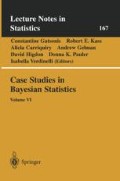Abstract
We model the response times for word recognition collected in experimental trials conducted on four subjects. Because of the sequential nature of the experiment and the fact that several replications of similar trials were conducted on each subject, the assumption of i.i.d. response times within experimental conditions (often encountered in the psychology literature) is untenable. We consider Bayesian hierarchical models in which the response times are described as conditionally independent Weibull random variables given the parameters of the Weibull distribution. The sequential dependencies, as well as the effects of response accuracy, word characteristics, and subject specific learning processes are incorporated via a linear regression model for the logarithm of the scale parameter of the Weibull distribution. We compare the inferences from our analysis with those obtained by means of instruments that are commonly used in the cognitive psychology arena. We pay close attention to the quality of the fits, the adequacy of the assumptions, and their impact on the inferential conclusions.
Access this chapter
Tax calculation will be finalised at checkout
Purchases are for personal use only
Preview
Unable to display preview. Download preview PDF.
References
Baranski, J. V. and Petrusic, W. M. (1998). Probing the locus of confidence judgments: Experiments on the time to determine confidence.Journal of Experimental Psychology: Human Perception and Per-formance, 24: 929–945.
Bayarri, MJ. and Berger, JO. (2000). P values for composite null models (C/R: pi 157-1171).Journal of the American Statistical Association, 95: 1127–1142.
Gelman, A., Carlin, JB., Stern, HS., and Rubin, DB. (1995).Bayesian data analysis. Chapman h Hall Ltd.
Gelman, A., Meng, X.-L., and Stern, H. (1996). Posterior predictive as-sessment of model fitness via realized discrepancies (Disc: p760–807).Statistica Sinica, 6: 733–760.
Guttman, I. (1967). The use of the concept of a future observation in goodness-of-fit problems.Journal of the Royal Statistical Society, Series B, Methodological, 29: 83–100.
Hayes, W. L. (1994).Statistics. Fort Worth: Harcourt Brace, 5 edition.
Hockley, W. E. (1984). Analysis of response time distributions in the study of cognitive processes.Journal of Experimental Psychology: Learning, Memory, and Cognition, 6: 598–615.
Kirk, R. E. (1995).Experimental Design:Procedures for the Behavioral Sciences. Pacific Grove, CA: Brooks/Cole, 3 edition.
Logan, G. D. (1988). Toward an instance theory of automatization.Psychological Review, 95: 492–527.
Logan, G. D. (1992). Shapes of reaction-time distributions and shapes of learning curves: A test of the instance theory of automaticity.Journal of Experimental Psychology: Learning, Memory, and Cognition, 18: 883–914.
Luce, R. D. (1986).Response times: Their role in inferring elementary mental organization. New York: Oxford University Press.
McCarthy, G. and Donchin, E. (1981). A metric for thought: A comparison of P300 latency and reaction time.Science, 211: 77–80.
McKoon, G. and Ratcliff, R. (1992). Inference during reading.Psychological Review, 99: 440–466.
Meng, X-L . (1994). Posterior predictive p-values. The Annals of Statistics, 22: 1142–1160.
Naylor, J. C. and Smith, A. F. M. (1988). An archaeological inference problem.Journal of the American Statistical Association, 83: 588–595.
Newell, A. and Rosenbloom, P. (1981). Mechanisms of skill acquisition and the law of practice. In Anderson, J. R., editor,Cognitive Skill and their Acquisition, pages 1 – 55. Hillsdale, NJ: Erlbaum.
Ratcliff, R. and Murdock, Jr., B. B. (1976). Retrieval processes in recognition memory.Psychological Review, 83: 190–214.
Robins, J. M., van der Vaart, A., and Ventura, V. (2000). Asymptotic distribution of p values in composite null models (C/R: pll57-1171).Journal of the American Statistical Association, 95: 1143–1156.
Rubin, D. B. (1984). Bayesianly justifiable and relevant frequency calculations for the applied statistician.The Annals of Statistics, 12: 1151–1172.
Scheffé, H. (1959).The Analysis of Variance. New York: Wiley.
Schmidt, R. A. and Russell, D. G. (1972). Movement velocity and movement time as determiners of degree of preprogramming in simple movements.Journal of Experimental Psychology, 96: 315–320.
Simon, J. R. and Berbaum, K. (1990). Effect of conflicting cues on information processing: The ‘Stroop effect’ vs. the ‘Simon effect’.Acta Psychologica, 73: 159–170.
Spiegelhalter, J., Thomas, A., Best, N. G., and Gilks, W. R. (1996).BUGS Examples Volume 1, Version 0.5, (version ii). Cambridge, UK: MRC Biostatistics Unit.
Townsend, J. T. and Ashby, F. G. (1983).Stochastic modeling of elementary psychological processes. New York: Cambridge University Press.
Van Zandt, T. (2000). ROC curves and confidence judgments in recognition memory.Journal of Experimental Psychology: Learning, Memory, and Cognition, 26: 582–600.
Weisberg, S. (1985).Applied Linear Regression. New York: John Wiley & Sons, 2 edition.
Winer, B., Brown, D. R., and Michels, K. M. (1991).Statistical Principles in Experimental Design. New York: McGraw Hill.
Editor information
Editors and Affiliations
Rights and permissions
Copyright information
© 2002 Springer Science+Business Media New York
About this paper
Cite this paper
Peruggia, M., Van Zandt, T., Chen, M. (2002). Was it a car or a cat I saw? An Analysis of Response Times for Word Recognition. In: Gatsonis, C., et al. Case Studies in Bayesian Statistics. Lecture Notes in Statistics, vol 167. Springer, New York, NY. https://doi.org/10.1007/978-1-4612-2078-7_17
Download citation
DOI: https://doi.org/10.1007/978-1-4612-2078-7_17
Publisher Name: Springer, New York, NY
Print ISBN: 978-0-387-95472-1
Online ISBN: 978-1-4612-2078-7
eBook Packages: Mathematics and StatisticsMathematics and Statistics (R0)

